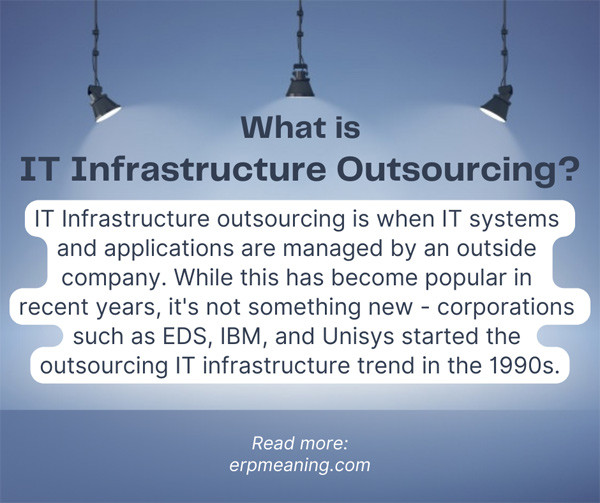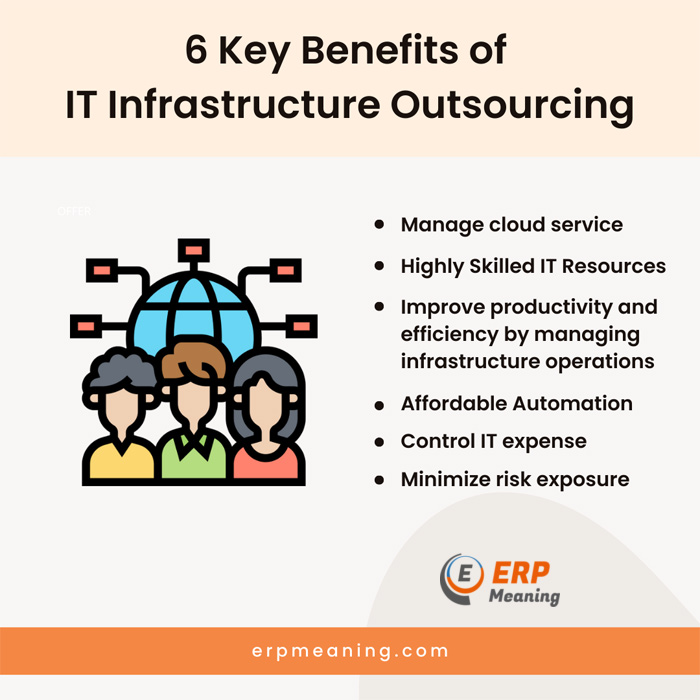
IT Infrastructure outsourcing is when IT systems and applications are managed by an outside company. While this has become popular in recent years, it’s not something new – corporations such as EDS, IBM, and Unisys started the outsourcing IT infrastructure trend in the 1990s. When they did this, they seized full ownership of the client companies’ employees and IT assets.
Understanding IT infrastructure outsourcing?
IT infrastructure outsourcing refers to hiring an external company or service provider to handle all or part of your organization’s information technology (IT) needs. This can include managing servers, maintaining networks, and providing cloud storage solutions.
Usually, a company’s IT infrastructure and applications are managed remotely from the service provider’s data center. Some businesses choose contractors with local facilities, while others outsource to companies based offshore. In either case, the contractor usually guarantees that all of their client’s IT assets will be available when needed by taking proactive measures and performing remedial actions as required. For most companies, this availability applies not only to servers but to other assets as well.
Outsourcing IT infrastructure provides many companies with an opportunity to reduce the cost and complications of IT service provisioning, particularly those without dedicated IT resources. Even if a company has its own IT department, it can still benefit greatly from tracking where its money is going while obtaining the required IT services. With an ideal solution, an organization has the potential to streamline its infrastructure and lower the expense of IT operations significantly.
How Does Outsourcing IT Infrastructure Work?
IT infrastructure services can be tailored to your organization’s requirements, depending on your service provider’s availability.
To understand your company and where you want to go, your IT advisors will start by asking questions about what isn’t working well and what you hope to achieve. They may even pay a visit to see things for themselves and get a sense of how everything works.
After that, your IT advisor will talk to you about whether your organization might need new physical technology (like updated phones) or if there are any issues with your internet connectivity that could be slowing down productivity.
After your IT provider has taken the time to understand what specific needs your company has, they will be able to share with you some potential solutions. If you agree with the plan of action they propose, they will create a comprehensive guide for managing and supporting your business going forward.
IT infrastructure outsourcing must be unique for each organization, as every company has different technological needs.
How to save money by IT Infrastructure Outsourcing?
If you thought outsourcing IT infrastructure was expensive, think again! Managing your systems adds up quickly and is usually more costly than simply outsourcing the same services.
If you outsource your IT infrastructure tasks can save your business a lot of money that would have been spent on labor and payroll. With an outsourced team, you can scale back or increase support depending on how busy times of year are for your company or if growth starts to take off. This is opposed to managing an in-house IT team which is always changing.
By outsourcing your IT infrastructure support, your internal IT team can focus on their primary tasks while having peace of mind knowing that a scalable and reliable external source is meeting your IT needs.
6 Key Benefits of IT infrastructure outsourcing:

1. Manage cloud service
According to a recent study, over 70% of IT leaders said they experienced negative effects after quickly transitioning to remote work with cloud technology last year. Now that things are calming down, CIOs are relying on outsourcers to help them make better cloud decisions, manage services correctly, and fix common mistakes from working quickly during the pandemic.
End-to-end cloud transformation requires specialized skill sets and a different way of thinking. Technical IT skills gaps are common: for example, many IT departments lack experience with the tools used by their chosen cloud provider.
2. Highly Skilled IT Resources
When you outsource your IT infrastructure needs, you have access to a team of highly skilled engineers and experts who can help transform your cloud workflows. These professionals can offer guidance on best practices and recommend optimising your cloud services for maximum performance and cost efficiency.
3. Improve productivity and efficiency by managing infrastructure operations
The IT infrastructure is vital for any company; however, with all the other demands for attention, it’s easy to let day-to-day management become a break/fix approach. This method decreases productivity and wastes time spent putting out metaphorical fires rather than working on more important tasks. In comparison, your Outsourcer’s primary focus is reliable IT infrastructure management. Quality providers have pre-existing processes and best practices that proactively resolve most issues, so they don’t interfere with productivity.
4. Affordable Automation
Automation is important for any business to ensure its processes are efficient and reliable.
Another cost-effective advantage of outsourcing your IT infrastructure management is that you can utilize a quality provider’s automation capabilities. By choosing an outsourcer with a comprehensive automation platform, you benefit from increased productivity and service consistency with tools like Incident Management, Alert Monitoring, and Robotic Process Automation (RPA).
5. Control IT expense
As your business grows, so will your IT needs. With an outsourcer, you can be confident that contracting with a highly skilled team of specialists will help you control your IT expenses while ensuring reliable and efficient services. Not only do you avoid paying the high turnover rates of an in-house IT team, but you also have access to flexible billing options like project-based pricing or pay-as-you-go plans.
When you outsource, you’re essentially changing fixed IT costs into variable ones. This allows you to adjust infrastructure resources as necessary instead of paying for an entire in-house team. Additionally, it eliminates expenses often related to office space rental, staffing, managing employee requests and absences, and training new personnel.
By outsourcing, CIOs can avoid wasting time and money on unimportant IT roles. Instead, they can focus on hiring people for positions that will directly help the company achieve its goals.
6. Minimize risk exposure
By outsourcing your IT infrastructure needs, you also gain the expertise of a team that has experience working with cloud-based services and other emerging technologies. This means you can reduce your company’s risk exposure by leveraging proven best practices and avoiding unnecessary downtime. Additionally, an outsourced provider will have their own systems in place to safeguard sensitive data and maintain security compliance.
Things to consider before IT infrastructure outsourcing
Outsourcing your IT infrastructure solutions can save your business a lot of money, but only if you first understand your needs and objectives. A comprehensive assessment is key to understanding what your company needs, followed by an evaluation of its initiatives, goals, and growth plans. Once you have this information mapped out, you can confidently start outsourcing your IT infrastructure.
Consider the following internal and external applications to develop a clear understanding of how your business works and which outsourcing it infrastructure would be most beneficial.
View of your company’s business initiatives over the next 1 to 5 years
If your company is looking to improve its market position, you must have a comprehensive view of your company’s business initiatives. This way, you can ensure that your infrastructure supports achieving these goals. If not, you will need to update and deploy your infrastructure accordingly.
Departmental Goals
It is critical for the IT department to be in tune with other departments’ goals and initiatives so that we can best support them. The IT department should always strive to be a solutions center for all other departments and help improve their business results. However, it is important to set expectations upfront and realistically manage our goal-setting.
Growth into business segments or new markets
If your company plans to expand into new markets or business segments, you will need infrastructure services that can grow with you. Technology changes happening now may be different than what’s needed to meet your future goals. It’s important to consider the technology and whether the financial cost fits within your budget.
When choosing where to open offices or deploy data center space, consider any tax benefits different states or countries offer. In some parts of the world, network connectivity can be very expensive, so make sure you know the going rates before signing a long-term lease.
Acquiring plan for the next couple of years
If you want to avoid building up a company with old and ineffective equipment, do your research before acquiring other businesses. When choosing new IT services, consider the preexisting systems so that you can be sure to use technologies that will work best for all areas of the business.
New product release
Whenever you introduce new products, it’s essential to upgrade your infrastructure as well. To make sure the change goes well, talk to every department affected. Knowing their product roadmaps and what they want to achieve, you can give them the most efficient and cost-effective solution while still making more money.
Proper selection of purchasing model
As technology advances rapidly, it has become less predictable to plan; IT needs in advance. To take advantage of these new opportunities while minimizing risk, many organizations now invest in technology as operational costs through a pay-per-use model instead of signing long-term purchase agreements.
Depending on where your company is in its cycle, the OpEx model may or may not make sense at this time. The financial focus should always be at the forefront of any business decision; weigh your options and do what makes cents for your company, literally and figuratively.
Conclusion
Overall, there are many things to consider when deciding which IT infrastructure outsourcing your business should use. Whether you want to improve your market position, grow into new markets or product releases, or just make sure your infrastructure is up-to-date with the latest technologies, it is important to consider all internal and external applications before making any decisions. In the end, if you look at your company’s goals and business needs as a whole, you can ensure that your infrastructure supports your overall growth plan.
